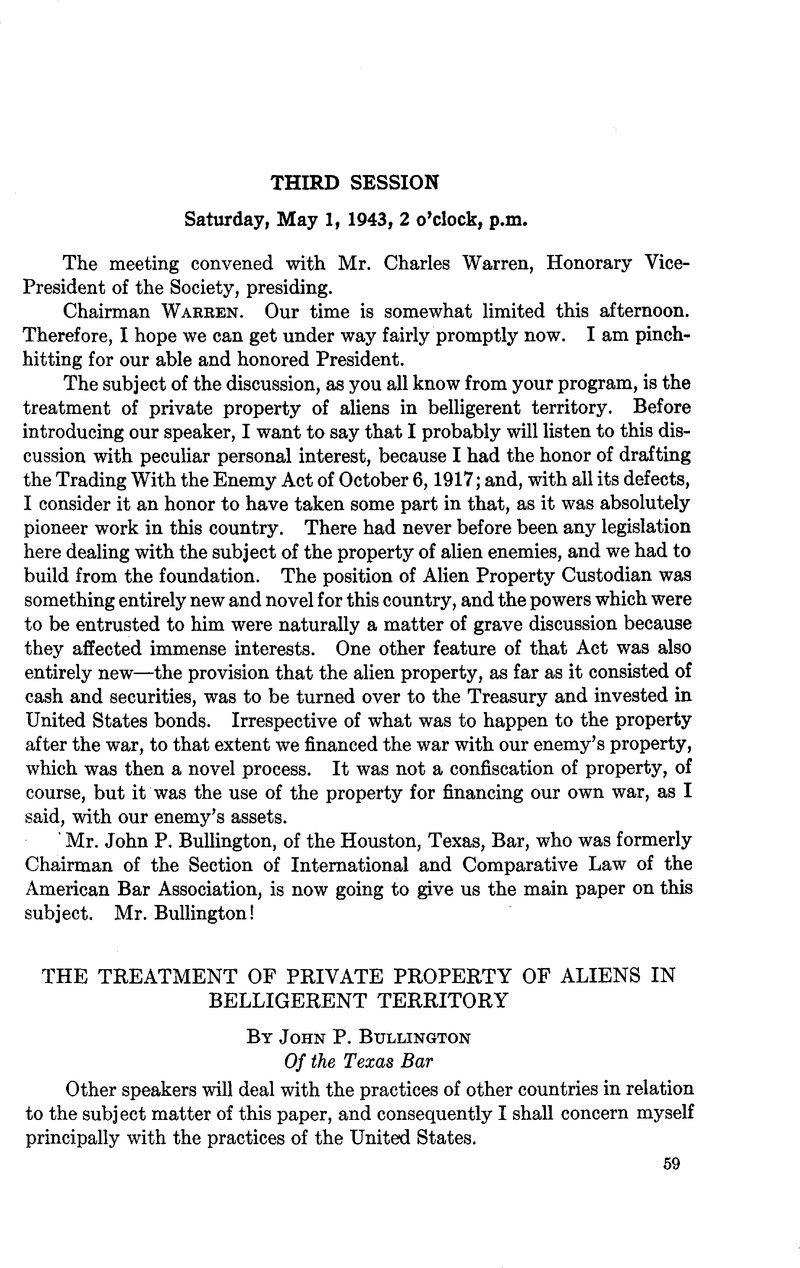No CrossRef data available.
Published online by Cambridge University Press: 27 February 2017

1 The considerable volume of literature on the subject is collected and discussed in Gathings, International Law and American Treatment of Alien Enemy Property, Washington, D. C, 1940. See also Lutz, , “Treatment of Private Property of Aliens on Land in Time of War,” Proceedings, American Society of International Law, 1933, p. 110 Google Scholar. A different view is presented by Turlington, , “Treatment of Enemy Private Property in the United States Before the World War,” 22 American Journal of International Law, p. 270 (1928).CrossRefGoogle Scholar
2 Moore, , “Post-War International Law,” 27 Col. L. R., pp. 400, 408 (1927).Google Scholar
3 Moore, , International Law and Some Current Illusions, New York, 1924, p. 24.Google Scholar
4 40 Stat. 411, Part 1.
5 For all practical purposes the right of the owner to sue disappeared after the Act of Nov. 4, 1918, since thereafter the Alien Property Custodian was treated as the “owner” with the sole right to sue. Hicks v. Anchor Packing Co., 16 F. (2d) 723 (CCA, 3rd, 1926). Cf. Farbwerke v. Chemical Foundation, 283 U. S. 152 (1931).
6 40 Stat. 459, Part 1.
7 40 Stat. 1020, Part 1.
8 See Gathings, op. tit., Ch. VI.
9 42 Stat. 1511, Part 1.
10 45 Stat. 254, Part 1.
11 Gathings, op. cit., p. 100.
12 See the discussion in Hyde, International Law, Boston, 1922, Vol. II, �622. If, through dummy corporations or otherwise, the enemy government is in fact the owner of seized industrial property, a different case with respect to holding the property or proceeds as security would, of course, be present.
13 55 Stat. 839.
14 Executive Order 9095,7 F. R. 5205.
15 E.g., 8 F. R. 3647-3648.
16 And also with the possible exception of the Custodian's action in confiscating 29 Italian and German ships which may possibly be explained on grounds other than mere enemy alien ownership. See Press Release, Office of War Information, Office of the Alien Property Custodian, Friday, July 24, 1942.
17 Patents at Work, A Statement of Policy, The Alien Property Custodian of the United States [Washington], January, 1943.
18 Loc. cit., footnote 17, p. 11.
19 See the discussion of Borchard, “Nationalization of Enemy Patents,” 37 American Journal of International Law, p. 92 (1943).
20 5 F. R. 1400.
21 Administration of the War Time Financial and Property Controls of the United States Government, United States Treasury Department, Foreign Funds Control, Washington, D. C, 1942, p. 3. This document contains a comprehensive résumé of the measures taken for financial and property controls over alien property.
22 Executive Order 8389, Sec. 5E. See also Sommerich, “Recent Innovations in Legal and Regulatory Concepts as to the Alien and His Property,” 37 American Journal of International Law, p. 58 (1943).
23 Loc. cit., footnote 21, p. 35. See also the discussion of Turlington, “Vesting Orders Under the First War Powers Act, 1941,” 36 American Journal of International Law, p. 460 (1942).
24 8F. R. 49, 89, et seq.
25 Loc. cit., footnote 17, supra, pp. 6-7.
26 Anderson v. N. V. Transandine Handelmaatschappij, 289 N. Y. 9, 43 N. E. (2d) 502 (1942).
27 Norwegian Shipping Claims Case, 27 American Journal of International Law, p. 362 (1923).
28 Russian Volunteer Fleet v. United States, 282 U. S. 481 (1931).
29 E.g., Norway, Art. I, 48 Stat. 1508, Part 2.
30 If confiscatory practices be continued during the present war, it may be necessary to buttress the formerly accepted rule of non-confiscation by treaties. It is to be hoped, however, that alien enemy property will not be so treated as to make this retrogression necessary.